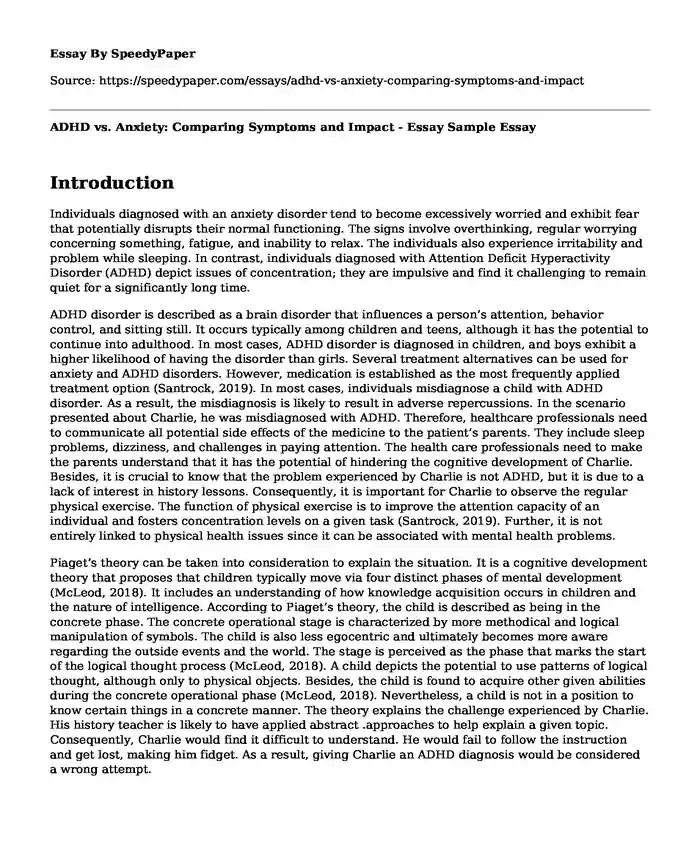
| Type of paper: | Essay |
| Categories: | Anxiety disorder Mental disorder Disorder |
| Pages: | 3 |
| Wordcount: | 631 words |
Introduction
Individuals diagnosed with an anxiety disorder tend to become excessively worried and exhibit fear that potentially disrupts their normal functioning. The signs involve overthinking, regular worrying concerning something, fatigue, and inability to relax. The individuals also experience irritability and problem while sleeping. In contrast, individuals diagnosed with Attention Deficit Hyperactivity Disorder (ADHD) depict issues of concentration; they are impulsive and find it challenging to remain quiet for a significantly long time.
ADHD disorder is described as a brain disorder that influences a person’s attention, behavior control, and sitting still. It occurs typically among children and teens, although it has the potential to continue into adulthood. In most cases, ADHD disorder is diagnosed in children, and boys exhibit a higher likelihood of having the disorder than girls. Several treatment alternatives can be used for anxiety and ADHD disorders. However, medication is established as the most frequently applied treatment option (Santrock, 2019). In most cases, individuals misdiagnose a child with ADHD disorder. As a result, the misdiagnosis is likely to result in adverse repercussions. In the scenario presented about Charlie, he was misdiagnosed with ADHD. Therefore, healthcare professionals need to communicate all potential side effects of the medicine to the patient’s parents. They include sleep problems, dizziness, and challenges in paying attention. The health care professionals need to make the parents understand that it has the potential of hindering the cognitive development of Charlie. Besides, it is crucial to know that the problem experienced by Charlie is not ADHD, but it is due to a lack of interest in history lessons. Consequently, it is important for Charlie to observe the regular physical exercise. The function of physical exercise is to improve the attention capacity of an individual and fosters concentration levels on a given task (Santrock, 2019). Further, it is not entirely linked to physical health issues since it can be associated with mental health problems.
Piaget’s theory can be taken into consideration to explain the situation. It is a cognitive development theory that proposes that children typically move via four distinct phases of mental development (McLeod, 2018). It includes an understanding of how knowledge acquisition occurs in children and the nature of intelligence. According to Piaget’s theory, the child is described as being in the concrete phase. The concrete operational stage is characterized by more methodical and logical manipulation of symbols. The child is also less egocentric and ultimately becomes more aware regarding the outside events and the world. The stage is perceived as the phase that marks the start of the logical thought process (McLeod, 2018). A child depicts the potential to use patterns of logical thought, although only to physical objects. Besides, the child is found to acquire other given abilities during the concrete operational phase (McLeod, 2018). Nevertheless, a child is not in a position to know certain things in a concrete manner. The theory explains the challenge experienced by Charlie. His history teacher is likely to have applied abstract .approaches to help explain a given topic. Consequently, Charlie would find it difficult to understand. He would fail to follow the instruction and get lost, making him fidget. As a result, giving Charlie an ADHD diagnosis would be considered a wrong attempt.
Conclusion
Misdiagnosis includes a situation where a doctor tells a person has some condition or illness, although it is not correct. Misdiagnosis is likely to happen in certain disorders such as ADHD disorder. It leads to a patient failing to receive the required treatment or treatment is given for a wrong illness. Misdiagnosis has the potential of causing harm due to treatment for the wrong condition.
References
McLeod, S. (2018). Jean Piaget’s theory of cognitive development. Simply psychology, 1-9.
Santrock, J. W. (2019). Life-span development (17th ed.). New York, NY: McGraw-Hill Education.
Cite this page
ADHD vs. Anxiety: Comparing Symptoms and Impact - Essay Sample. (2023, Nov 25). Retrieved from https://speedypaper.net/essays/adhd-vs-anxiety-comparing-symptoms-and-impact
Request Removal
If you are the original author of this essay and no longer wish to have it published on the SpeedyPaper website, please click below to request its removal:
- Free Essay on General Social Anxiety Disorder and Social Anxiety Disorder
- Paper Example - Alcohol, Drugs and Deviant Behavior
- Essay Sample on Attention-Deficit Hyperactivity Disorder (ADHD)
- Free Essay: The Symptoms of Generalized Anxiety Disorder
- Essay Example: Attention-Deficit/Hyperactivity Disorder (ADHD)
- Living With Dementia: My Experience
- Paper Sample on Patient Analysis
Popular categories




